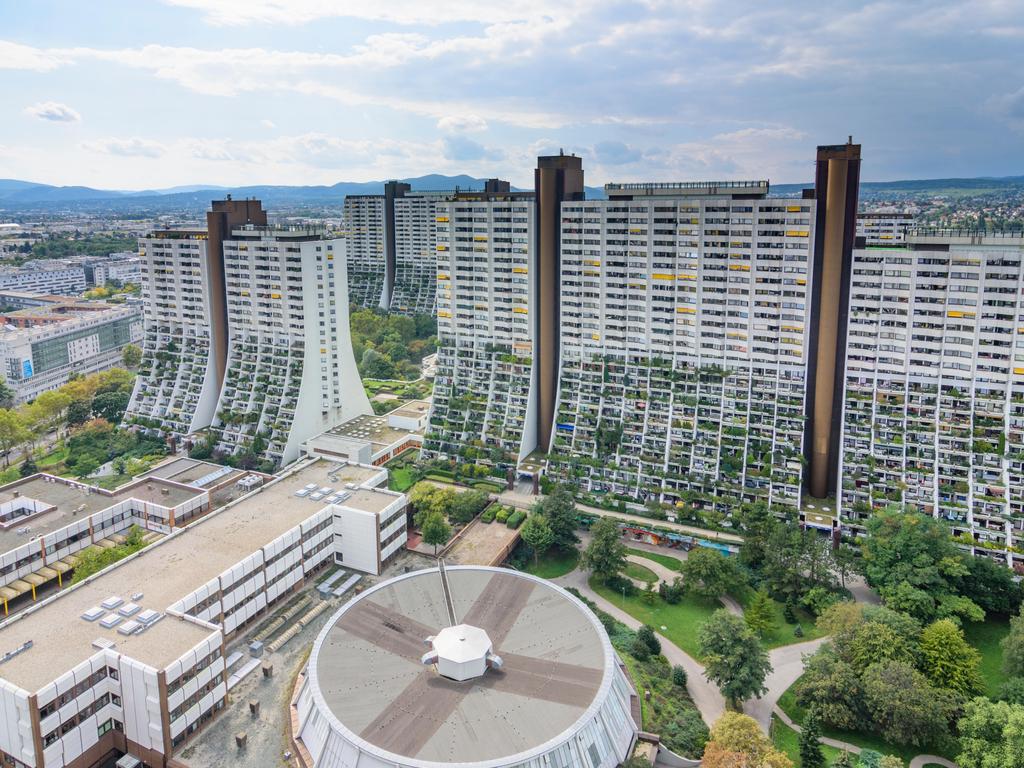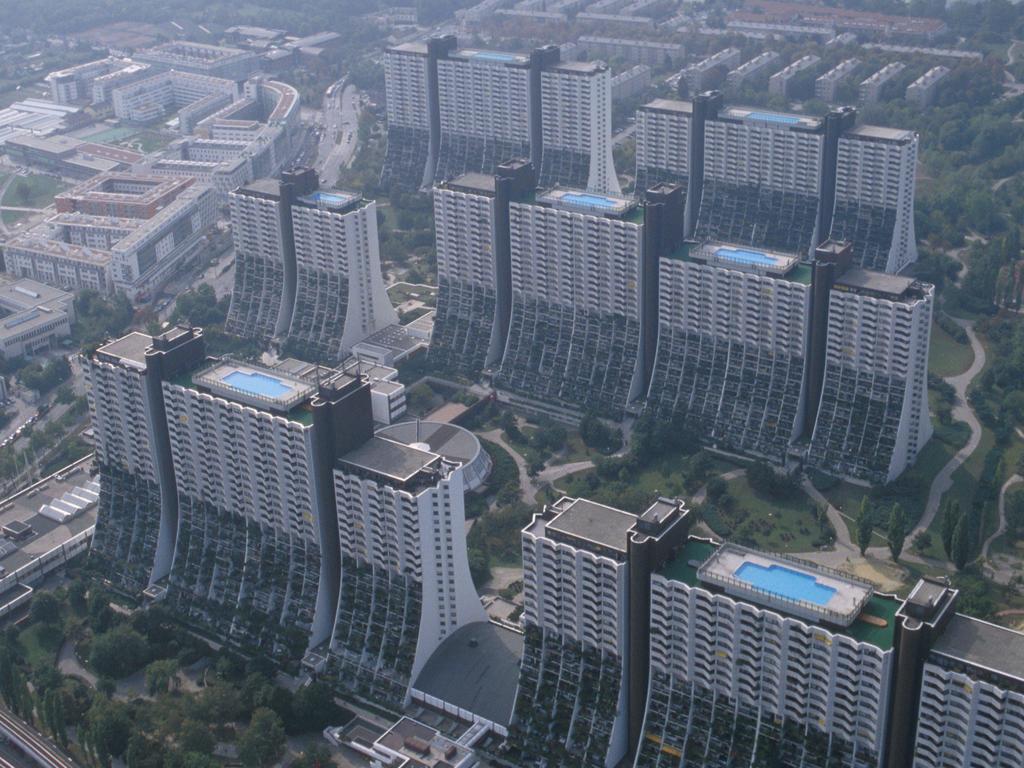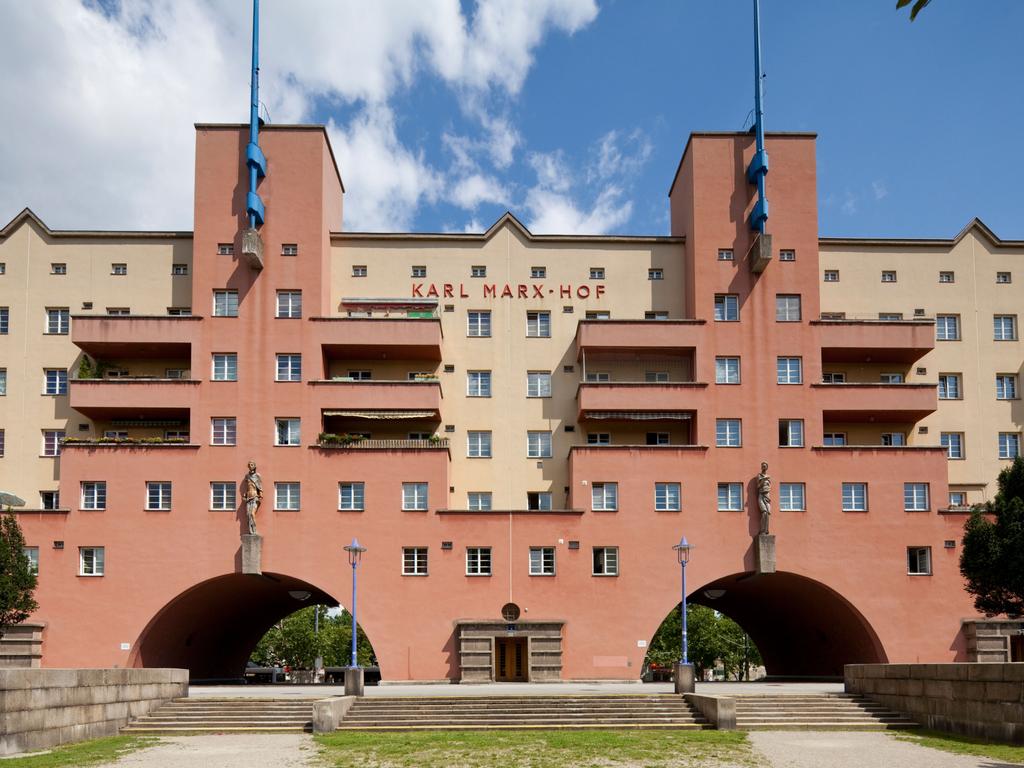‘Renter’s utopia’: Greens say Vienna proves public housing can be high-quality and affordable for all
A major city where most residents live in high-quality, affordable public housing has been held up as a model for Australia to follow.
A major European city where most residents live in high-quality public housing has been held up as a “renter’s utopia” that could point the way out of Australia’s current crisis.
Vienna, Austria, has long been hailed for its progressive social housing policies, which started in the 1920s and 30s and today see more than 60 per cent of the city’s 1.8 million residents living in subsided housing, while more than half of the housing market is either city-owned flats or cooperative apartments.
Eighty per cent of Viennese are renters, and thanks to strict rent control laws pay only 20 to 25 per cent of their income on housing — and in some cases as little as 8 per cent — compared with more than 30 per cent in Australia.

Vienna’s Gemeindebauten, or council estates, are also uniquely high-quality and beautifully built — unlike post-war housing projects commissioned in many other cities such as Paris or London — and are not exclusively for the poor.
The income cap to access social housing is so high that 80 per cent of people qualify, and once approved contracts never expire even if the resident’s income increases, leading to greater economic diversity within the communities.
“If people don’t have to struggle all day long to survive — if your life is made safe, at least in social conditions — you can use your energy for much more important things,” Peter Pilz, a former member of Austria’s Green Party who took over his grandmother’s social housing unit, told The New York Times last month.

In 2012, Mr Pilz caused controversy in Austria after a conservative newspaper claimed he was only paying 66.18 euros ($109.15) a month in rent for his apartment in the Goethehof Gemeindebauten on the Danube River, despite making more than 8000 euros ($13,000) a month in parliament.
The Viennese example has also been cited by The Greens in Australia, where 31-year-old housing spokesman Max Chandler-Mather has been locked in a political brawl with Prime Minister Anthony Albanese for holding up Labor’s signature $10 billion Housing Australia Future Fund (HAFF) until later this year.
The HAFF — an investment vehicle to raise funds for social and affordable housing projects — was one of Labor’s signature election promises but it is teetering on the brink of failure because the Greens are refusing to support it in its current form and the government needs their votes to pass legislation through the Senate without the Coalition’s support.

The Greens are ramping up their calls for a nationwide cap or freeze on rent increases after having successfully used their balance of power position in the Senate to demand guaranteed funding for housing projects from the returns the HAFF generates.
Tasmanian Senator Jacqui Lambie earlier this month slammed The Greens for delaying the HAFF, accusing the party of “playing with people’s lives”. “They sit there and they pride themselves on their social values and that they are there for the most vulnerable people,” she said in a blow-up on Sky News.
“If this is the way of them showing that that’s what they are there for, bloody crap. Stop playing with the most vulnerable people’s lives in Australia and get on and put this housing bill through today.”

But in a statement on Saturday, Mr Chandler-Mather said The Greens would “keep negotiating” on the bill before it comes to the Senate in September. “As it stands Labor’s housing plan will see the crisis get worse because it does nothing for renters and doesn’t guarantee any spending until 2024/25,” he said.
“We are asking for $2.5 billion per year for public and affordable housing and $1 billion per year for a freeze on rent increases. This is less than the government’s surplus or less than 10 per cent of what they’re spending on the stage three tax cuts for the super wealthy. The only thing standing in the way here is Labor.”
Sharing The New York Times article on Twitter on Wednesday, Mr Chandler-Mather wrote, “The property industry and their allies will tell you the only way to tackle the housing crisis is to give property developers more power to do whatever they want. But that’s what got us in this mess in the first place. Vienna proves the reality is the exact opposite.”

He noted Vienna’s public and co-op housing was “beautifully built and provides amazing communal facilities like this pool and sauna”. “People from all walks of life live in these amazing homes, which are built for people not property developer profit,” he said.
Sydney filmmaker Jack Toohey, who created a series of viral TikTok videos about the housing crisis, also cited Vienna as an example of “high quality, affordable housing for all”.
“Nurses, teachers, tradies and all sorts of workers young and old live here, and they’re never kicked out even as they earn more,” he said in one video, describing it as proof that “public and private interests can work together to create affordable and liveable cities”.
“To get anywhere close to 60 per cent public housing is going to take a seismic shift in the way that we view housing,” he said.

Speaking to Politico last year, Vienna’s deputy mayor Kathrin Gaal said the city’s social housing policies had been “shaped by the political commitment that housing is a basic right”.
“We insisted on not privatising social housing in the 1980s and 90s, when other cities were selling their municipal housing projects,” she said. “Today, more than ever, we can see that this strategy has been successful — once the apartments are gone, the city has only a small lever to regulate rents.”
The public and co-op housing is beautifully built and provides amazing communal facilities like this pool and sauna. People from all walks of life live in these amazing homes, which are built for people not property developer profit. pic.twitter.com/ieXgqr3boB
— Max Chandler-Mather (@MChandlerMather) June 27, 2023
Even though they were initially built to house the thousands of industrial workers and refugees after the end of World War I, Vienna’s Gemeindebauten were designed to be indistinguishable from the private buildings housing the city’s wealthier residents.
Complexes included decorations such as statues and featured open courtyards as well as clinics, shops, kindergartens and libraries. Today communal facilities such as pools and saunas are common.
“[These were] for the people who lived there, but also for the broader community,” Eve Blau from Harvard University’s Davis Center for Russian and Eurasian Studies told Politico.
Ms Blau dubbed the century-old policies of Vienna’s ruling Social Democratic Party “municipal socialism”.
“In the end it’s not about housing,” she said. “It’s about giving the people the right to the city.”
— with NCA NewsWire






